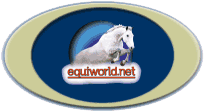Stress and poor health take their toll on a horse's immune system, making the horse an easy target for viral and fungal bacteria to cause havoc. This sounds logical and has been proven time and time again. Where as there is not supposed to be any pain related to neurological issues and research says that the horse really doesn't know there is a problem, there should be very little stress for the animal. At least in cases where the animal is not continually falling down and/or injuring it's self.
As we take this road less traveled with Fear, we are finding that even though Fear is perfectly healthy in every other way, he is more susceptible to germs. Out of the blue, he came down with a case of ringworm. No idea where it could have come from. He has been in the same pasture and stall for months now and no outside horses have been on the farm. No other horses came down with it prior to or at the same time. After treatment from the vet, it has slowly gone away. The vet chalked it up to stress, and said that even though reports say there is no stress related to neurological disorders, no one can be sure. So we have been keeping a closer eye on him and we have a pretty good idea that his problems are no secret to him. He truly seems to know that things aren't right. When he takes a corner and loses his balance, he looks at us with worried eyes and reaches his nose out for reassurance from us. If he misjudges his stride and bumps into a stall wall, there are those worried eyes again. He knows………there is no denying it.
Tuesday, November 4, 2008
Subscribe to:
Post Comments (Atom)
Latest Video Oct 28, 2008
Watch for Updates
Continue to check back for Updates on Fear, new pictures and soon a video!














No comments:
Post a Comment